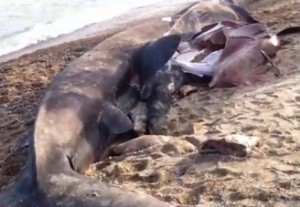Basking Shark Lands on Misquamicut Beach
 Media Release
Media Release
NOAA Fisheries Service
30. April 2013
——————–
You never know when the phone will ring, bearing data. You might be doing a little yard work like Lisa Natanson was on Sunday. Then she got word that a basking shark was beached just a few minutes from her home.
Natanson is an NEFSC shark biologist with a long-running study involving shark backbones and other biological samples. These samples provide the basis for understanding how these sharks grow and reproduce as well as other aspects of their life histories. She thought it would be worth having a look at the fish to see if useful data could be collected.
“Basking sharks are common in our waters during much of the year,” said Natanson, “but we do not yet know enough about them. For example, basking sharks cannot be aged using traditional methods so there is not yet a reliable method for figuring out exactly how old an individual is.”
 Arriving on the scene at Misquamicut Beach in Westerly, R.I. on Sunday afternoon, Natanson and her colleague Nancy Kohler were able to take some basic information: gender (male), length (28.5 ft), species confirmation (basking shark), and maturity stage (mature). “There were no obvious outward signs of injury that we could see,” said Natanson,” but a good portion of the animal was buried in the sand so we couldn’t examine the whole fish.” When the waves became too high, the pair wound down sampling.
Arriving on the scene at Misquamicut Beach in Westerly, R.I. on Sunday afternoon, Natanson and her colleague Nancy Kohler were able to take some basic information: gender (male), length (28.5 ft), species confirmation (basking shark), and maturity stage (mature). “There were no obvious outward signs of injury that we could see,” said Natanson,” but a good portion of the animal was buried in the sand so we couldn’t examine the whole fish.” When the waves became too high, the pair wound down sampling.
Natanson had hoped to return to the scene later to collect the backbone, but eventually decided against further sampling having obtained the priority data. “While I have other basking shark backbones for study,” she said, “this is only the fifth male basking shark we have dissected for reproduction so that was the most important sample.”
Many sharks can be aged by looking at hard parts like backbones, but not so the basking shark. Natanson and her colleagues have shown that growth bands, similar to those in tree trunks, are also found in basking shark vertebrae but are not laid down in a pattern that appears related to time. However they are still looking for other methods of aging.
Shark backbones are not bony, but instead are composed of cartilage. Cartilage is relatively rigid, but lighter and more flexible than bone.
NOAA’s National Marine Fisheries Service manages 72 shark species in Atlantic waters and the commercial and recreational fisheries for sharks in US waters. Shark finning is prohibited in the U.S. and fishermen may not possess basking sharks.
The basking sharks off the Northeast are not listed under the federal Endangered Species Act. Those that occur in the North Pacific are a species of concern under the U.S. act and endangered under the similar Canadian act, and listed as endangered by the International Union for Conservation of Nature. Basking sharks are also listed in Appendix II of the Convention on International Trade in Endangered Species (CITES). These are species that convention members recognize as not necessarily threatened with extinction at this time, but that may become so unless trade is closely controlled.
Source: NOAA
Photo Credit: HiDFoxx (youtube)
Note by Shark Year Magazine :
A video of the basking shark can be found in our Video Section: Basking Shark Dead on Westerly, R.I. Shore
——————
